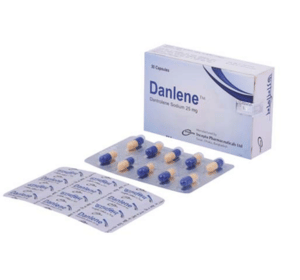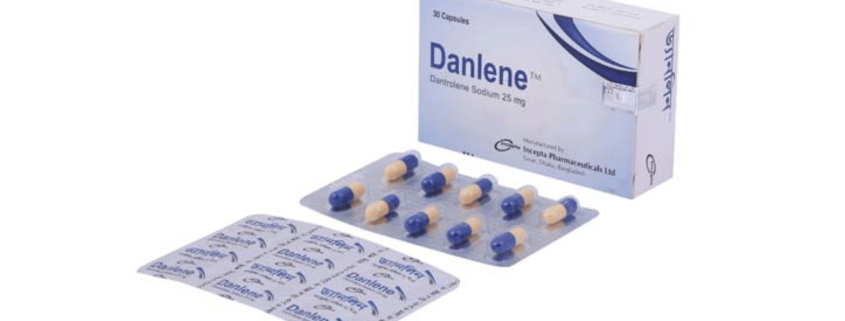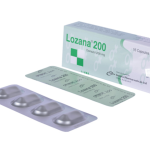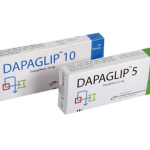Danlene(Dantrolene Sodium )

Therapeutic Group: Skeletal Muscle Relaxant
Presentation
Danlene Capsule: Each capsule contains Dantrolene Sodium USP 25 mg.
Description
Dantrolene produce relaxation by affecting the contractile response of the skeletal muscle. In skeletal muscle, Dantrolene dissociates the excitation-contraction coupling, probably by interfering with the release of Ca++ from the sarcoplasmic reticulum.
Indications
In Chronic Spasticity: Dantrolene is indicated in controlling the manifestations of clinical spasticity resulting from upper motor neuron disorders (e.g., spinal cord injury, stroke, cerebral palsy or multiple sclerosis). It is of particular benefit to the patient whose functional rehabilitation has been retarded by the sequelae of spasticity. Dantrolene is not indicated in the treatment of skeletal muscle spasm resulting from rheumatic disorders.
A decision to continue the administration of Dantrolene on a long-term basis is justified if introduction of the drug into the patient’s regimen:
• produces a significant reduction in painful and/or disabling spasticity such as clonus, or
• permits a significant reduction in the intensity and/or degree of nursing care required, or
• rids the patient of any annoying manifestation of spasticity considered
important by the patient himself.
In Malignant Hyperthermia: Oral Dantrolene is also indicated preoperatively to prevent or attenuate the development of signs of malignant hyperthermia in known, or strongly suspect, malignant hyperthermia susceptible patients who require anesthesia and/or surgery.
Dosage & Administration
For Use in Chronic Spasticity: It is important that the dosage be titrated and individualized for maximum effect. The lowest dose compatible with optimal response is recommended.
Each dosage level should be maintained for seven days to determine the patient’s response. If no further benefit is observed at the next higher dose, dosage should be decreased to the previous lower dose.
Adults:
25 mg once daily for seven days, then 25 mg t.i.d. for seven days, 50 mg t.i.d. for seven days, 100 mg t.i.d.
Pediatric Patients:
0.5 mg/kg once daily for seven days, then 0.5 mg/kg t.i.d. for seven days, 1 mg/kg t.i.d. for seven days, 2 mg/kg t.i.d.
Therapy with a dose four times daily may be necessary for some individuals. Doses higher than 100 mg four times daily should not be used.
For Malignant Hyperthermia:
Preoperatively: 4 to 8 mg/kg/day of oral Dantrolene in 3 or 4 divided doses for one or two days prior to surgery, with the last dose being given approximately 3 to 4 hours before scheduled surgery with a minimum of water.
Post Crisis Follow-up: Oral Dantrolene should also be administered following a malignant hyperthermia crisis, in doses of 4 to 8 mg/kg per day in four divided doses, for a one to three day period to prevent recurrence of the manifestations of malignant hyperthermia.
Side Effects
The most frequently occurring side effects of Dantrolene have been drowsiness, dizziness, weakness, general malaise, fatigue, and diarrhea.
Other less frequent side effects are constipation, anorexia, abdominal cramps, nausea and/or vomiting, hepatitis, headache, visual disturbance, alteration of taste, insomnia, tachycardia, anemia, leukopenia, lymphocytic lymphoma, mental depression and mental confusion.
Precautions
Dantrolene should be used with caution in patients with impaired pulmonary function, particularly those with obstructive pulmonary disease, and in patients with severely impaired cardiac function due to myocardial disease. Dantrolene is associated with pleural effusion with associated eosinophilia.
Patients should be cautioned against driving a motor vehicle or participating in hazardous occupations while taking Dantrolene. Caution should be exercised in the concomitant administration of tranquilizing agents.
Dantrolene might possibly evoke a photosensitivity reaction; patients should be cautioned about exposure to sunlight while taking it.
Use in Pregnancy & Lactation
Pregnancy: Pregnancy Category C.
Nursing Mothers: Dantrolene should not be used in nursing mothers.
Usage in Pediatric Patients
The long-term safety of Dantrolene in pediatric patients under the age of 5 years has not been established.
Drug Interaction
Drowsiness may occur with Dantrolene therapy and the concomitant administration of CNS depressants such as sedatives and tranquilizing agents may result in further drowsiness.
Hepatotoxicity has occurred more often in women over 35 years of age receiving concomitant estrogen therapy.
Administration of Dantrolene may potentiate vecuronium-induced neuromuscular block.
Commercial Pack
Danlene Capsule: Each box contains 3 Alu-PVDC blister strips of 10 Capsules.



